In an increasingly uncertain world, the need for quick access to help in emergencies has never been greater. Panic buttons are designed to make quick alarms in emergencies. Serving as lifelines essential for all manner of settings, from offices to educational institutions to hospitals, their purpose is uncomplicated yet invaluable: pressed, they signal for help, assuring that help is on the way quickly.
The market of responding to emergencies is rapidly evolving, with wearable technologies and phone apps leading the pack of innovations. The size of the wearable panic button industry will grow from USD 368 million in 2025 to USD 511 million by 2032 at a CAGR of 5.7%. And the revenue contribution of North America in this will be 42%.
Organizations today have modern technologies that hugely improve their safety. We will delve into the best uses of these technologies, their future possibilities, their limitations, as well as their considerations to keep in mind.
For schools, integrating GPS tracking for school buses can further enhance safety by combining stationary panic buttons with real-time monitoring. Explore GPS tracking for school buses
Understanding Panic Buttons: Types and Technologies
Panic buttons are not yet universal. They come in numerous formats, all tailored to distinct safety needs among institutions such as schools and workplaces. For any business that would want to enhance emergency response, it's essential to know about the types of panic buttons out there and the technology driving them.
Types of Panic Buttons
Wearable Panic Buttons
They come as pendants, clipped devices, or wristbands. They are convenient to use and discreet in functionality. They enable one to alert without unnecessarily inciting attention. This feature is critical for environments where risks or dangers tend to prevail.
Stationary Panic Buttons
Panic buttons can also be permanently fixed at strategic locations around a building. They are usually located near exits, front desks, or special high-risk work areas. Once pressed in the event of an emergency, they alert immediate security staff or local authorities. Modern systems may integrate with live tracking, ensuring faster emergency response.
Mobile Apps
Panic button smart apps utilize smartphone functionality. A single touch point on the phone screen enables staff to alert with their immediate whereabouts. Typically, these apps relay such an alert to designated contacts or directly to police or other emergency services, often using GPS-enabled panic button technology.
Discover how advanced GPS tracking systems for transportation can streamline alert and response mechanisms. Learn more about Advanced GPS tracking systems for transportation
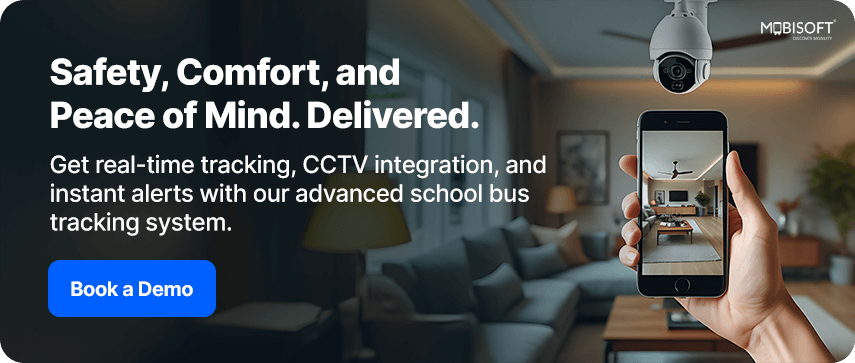
Key Features of Panic Buttons and Emergency Alert Systems
Panic buttons also incorporate other functionalities for higher efficiency:
- Silent Alarms: As the name suggests, the silent alarms function soundlessly, thereby refraining from notifying a potential assaulter and allowing victims to quietly seek help.
- Duress Alerts: Certain systems recognize a duress code or secret signal. Publicly, it appears to be a submission, but it activates a silent warning and position to security personnel or police.
- Automatic Location Sharing: These GPS-integrated panic buttons will transmit their owners' coordinates straight to respondents, greatly boosting the emergency response times.
- Real-Time Status Updates: Enhanced systems offer live tracking of responders and users, which ensures faster action during emergencies.
Technologies Used
The technologies behind panic buttons include:
- Bluetooth: Bluetooth technologies are common in most wearable panic buttons that connect with phone apps for easy interaction.
- Cellular Networks: Mobile apps usually depend on cell networks for sending notifications as well as location data.
- Satellite Technology: In peripheral locations where cellular connectivity may be intermittent, satellite connectivity is deployed such that panic buttons will always operate correctly.
User Experience and Design Considerations
Design and installation thus make all the difference between successful use and otherwise in actual emergencies. These alarms must be easy to use when one is already tensed. Ease of use is also vital; old employees or disabled employees might need devices specially designed with additional thought regarding ease of use. Additionally, businesses benefit from customizable products that will suit their specific space and employees.
Integration with Existing Emergency Response Infrastructures
For panic buttons to work effectively, they must integrate with existing emergency response systems. Alerts must be directly sent to security teams or on-site law enforcement without hindrance. This ensures the system does not just sound an alarm but closes the gap between alert and the immediate arrival of help.
Learn how GPS-enabled panic buttons can help transportation logistics and optimize safety response. See how GPS-enabled panic buttons can help transportation logistics
The Role of GPS and Live Tracking in Emergency Situations
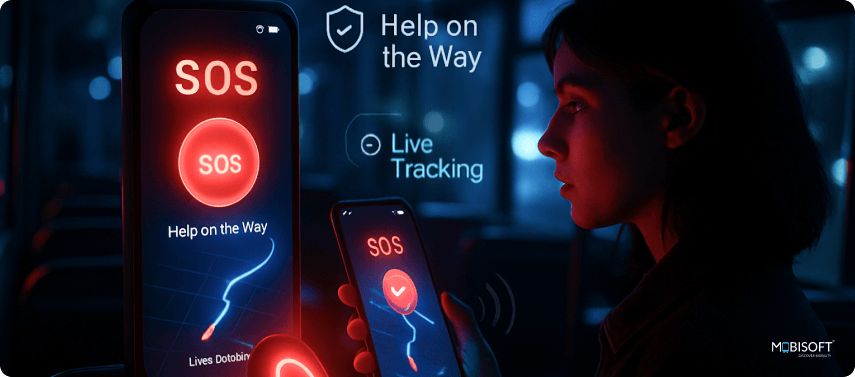
By combining panic buttons and GPS, their value multiplies many times. They are more than sending alerts by giving precise position information in real-time. They enable the responders to move quickly with certainty. This precision, during emergencies, saves lives.
Importance of Real-Time Location Tracking
Time is of value because here even seconds matter. Devices with built-in GPS remove confusion regarding where the user is located. Responders receive accurate coordinates instead of verbal instructions within a few seconds. That accuracy eliminates confusion and provides proper aid to the location. Even survival depends on timing at times.
How GPS Enhances Panic Button Functionality
GPS integration enhances panic buttons by:
- Precise Location Sharing: Users can send their location instantly, allowing responders to reach them without delay.
- Geofencing: Organizations can set up virtual boundaries that trigger alerts if an individual enters or exits designated areas, enhancing workplace safety protocols.
- Tracking Response Times: By reviewing GPS data, organizations can study how long it takes for help to arrive. This analysis allows them to update emergency procedures.
Response Time Improvements in Practice
Numerous organisations have documented astounding shortening of emergency response time following the deployment of GPS-enabled panic buttons. For example:
- Healthcare Facilities: One of the hospitals recorded a decline of 39% of violent events after adopting a panic button system that incorporated a GPS. Medical staff were empowered to ask for immediate help and receive immediate assistance.
- Corporate Environments: The company has issued wearable panic buttons for its workers. The reports mentioned that the response of security was quicker and consistent because teams were responding promptly to incidents.
- Educational Institutes: A school district brought in GPS panic button systems as part of new state rules. Staff, including gym teachers, administrators, and guards, were equipped with the devices. During safety drills, response times from security teams improved by over 50%. Parents and teachers shared positive feedback, noting the visible improvement in overall safety. The district could also meet compliance needs while protecting its community.
What These Examples Show
The examples above show that panic button systems with GPS boost overall safety when integrated effectively. The key is to customize solutions for each workplace and track performance to measure improvement. Regular reviews give organizations data they can use to enhance safety plans and response systems.
Safety features like panic buttons in event transport logistics can similarly reduce risks in large gatherings. Check Safety features like panic buttons in event transport logistics
The Numbers Behind Panic Button Adoption
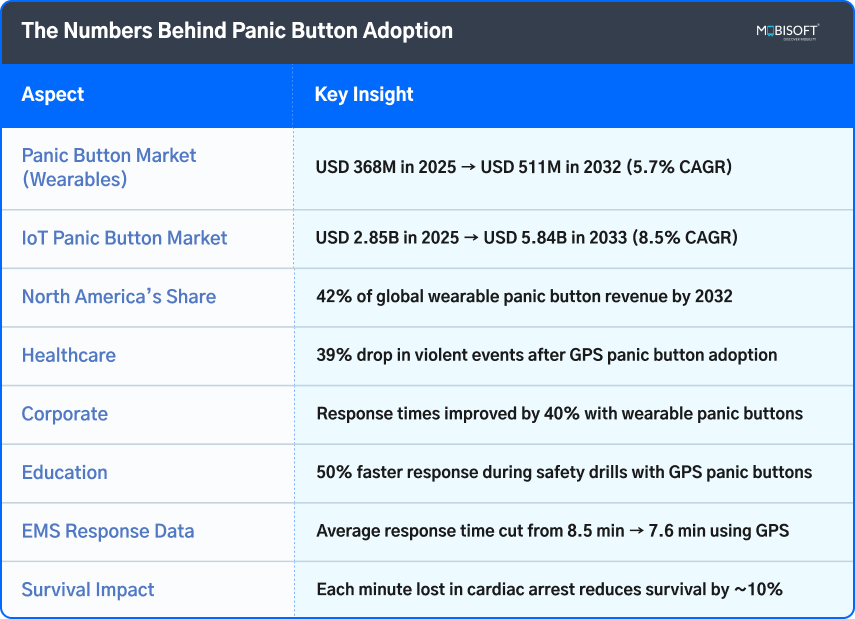
Challenges in GPS Tracking for Panic Buttons and Emergency Response
Despite its value, GPS tracking has limits:
- Signal Loss: Rural areas, especially in developing countries, experience a weak network. This often poses difficulties while tracking.
- Environmental Barriers: skyscrapers in big cities obstruct GPS signals, making tracking inefficient and even inaccurate sometimes.
These gaps can impact how well panic button systems function in critical cases.
Solutions to Overcome GPS Challenges
Innovative solutions are emerging to address these challenges:
- Satellite Connectivity: Utilizing satellite systems ensures that panic buttons remain operational, even in areas with poor cellular coverage.
- Hybrid Systems: Combining GPS with other technologies, such as Wi-Fi or Bluetooth, can enhance location accuracy and reliability.
The Impact of Geofencing on Workplace Safety
Geofencing can create an added layer of protection in high-risk industries. A virtual perimeter is defined around a site or facility. If a panic button alert comes from outside the zone, safety teams are notified instantly.
This applies especially to construction, field services, or remote work sites. Tracking movements against predefined zones allows managers to respond faster, protect workers, and secure assets using live tracking panic button devices.
Integrating Panic Buttons with GPS: A Comprehensive Approach
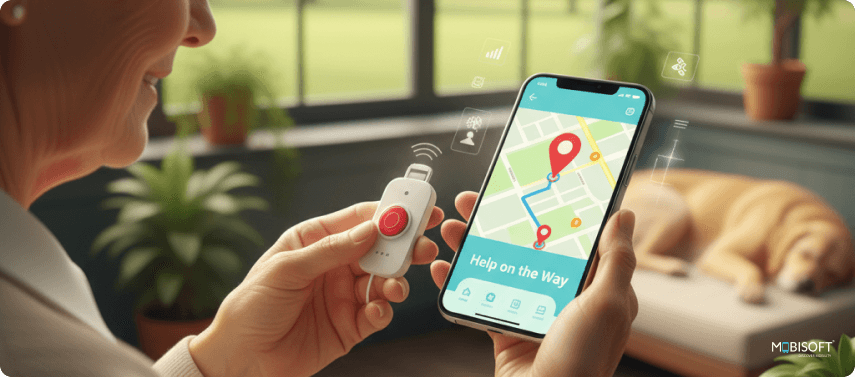
Incorporating GPS tracking with panic buttons demands more than just device installation. It requires an integrated plan, training, and systems that work harmoniously. When an organization follows the right steps, emergency response improves, and help arrives quickly in crises.
Effective Integration Steps
- Assess Needs: Every workplace offers unique safety hazards. Executing a risk assessment will help you identify those areas that offer the best return on panic buttons.
- Select Technology: Organizations need to select hardware and software after requirements become apparent. Compatibility, ease of use, and ease of incorporation of existing systems are paramount.
- Train Staff: Staff need to understand when and how to press panic buttons. Drills and training will make them feel more comfortable and familiar with them.
Customization Options for Different Industries
Requirements change with different sectors. The obstacles each face required customised technical solutions:
- Healthcare: Devices with automatic fall detection and discreet alert features help protect staff who face high risks of patient aggression.
- Education: Schools can use panic buttons that connect directly to local police, helping respond faster during crises like active shooter cases.
- Construction: Workers on construction sites can use GPS panic buttons as part of wearable safety gear, making alerts easier in remote or dangerous spots.
Legal and Regulatory Considerations
Organisations must comply with certain rules regarding safety systems. Companies in the United States are expected to comply with OSHA standards relating to worker safety. Some states require emergency alert systems with panic buttons in workplaces.
Data Privacy and Security
The use of GPS-enabled panic buttons creates the issue of misuse of worker location information. Companies need to implement high-level policies regarding data acquisition, storage, and utilization. Emergency use only is an acceptable use of the information. Encryption of data and access control also decreases the threats. Transparent notification of workers fosters trust and demonstrates that safety is the sole intent of the system.
Future Trends in Panic Button Technology
Tech is quickly changing, and even panic button systems with GPS are adapting as time goes by. Next-gen iterations will do more than raise the alarm; they will also capture data that averts crises. Newer technologies will provide companies with increased safety control and faster data transmission during crises.
AI analytics will play an increasingly prominent part. By analyzing patterns of response and alerts, AI will be able to predict potential risks and help strengthen safety planning. The information collected from past incidents will help organizations develop their emergency response procedures.
School bus safety with live tracking and cameras can complement panic button systems to safeguard students effectively. Read about School bus safety with live tracking and cameras
Challenges and Considerations in Implementation
Integration of panic buttons with GPS tracking has a lot of benefits, but is not challenge-free. Organizations need to identify issues early enough and prepare for them to integrate them effectively.
Common Obstacles
Organizations may face several obstacles, such as:
- Financial Constraints: Not all companies have room to spend on advanced safety systems like GPS-integrated panic buttons.
- Technology Compatibility: Old systems are not always compatible with new software upgrades. This often causes inaccuracies because of old hardware.
- Employee Resistance: New technology can be challenging, especially for people with unclear prerequisites. Employees even fear misuse of GPS tracking data, naturally so.
Financial Considerations
Installation of GPS-capable panic buttons involves initial costs and upkeep expenses. An analysis of costs against benefits considers the safety increment against financial stress. Organizations can consider grants, government initiatives, or private collaborations that favor workplace safety renovations as a way of mitigating risk.
Ensuring Reliable Connectivity
Connectivity sits at the core of panic button systems. Weak networks or outdated infrastructure can compromise alerts. Organizations must evaluate their current communication systems before deployment. In some cases, upgrading hardware or expanding coverage is essential to maintain reliable operations in remote or challenging sites.
Addressing Employee Resistance
Change requires participation. Involving employees in the planning stage as well as the implementation stage reduces fear and generates trust. Thorough training programs explain the use of panic buttons with GPS by highlighting safety over supervision. When staff regard the system as protection rather than monitoring, the adoption process is made easier.
Continuous Monitoring and System Updates
After installation, panic button systems with live tracking should not be treated as unchanging objects. Regular upkeep, occasional auditing, and immediate updating of the system help prevent breakages during tense situations.
Balancing Safety with Privacy
The installation of GPS tracking panic buttons requires cautious handling of privacy. Employees must be completely clear on exactly what will be done with their location data. Transparent communication plus strong privacy policies help preserve trust. When safety is balanced with privacy, acceptance levels rise and compliance strengthens.
Smart bus management with real-time tracking and safety features can improve operational efficiency and overall safety. Discover Smart bus management with real-time tracking and safety features
The Human Side of Panic Buttons
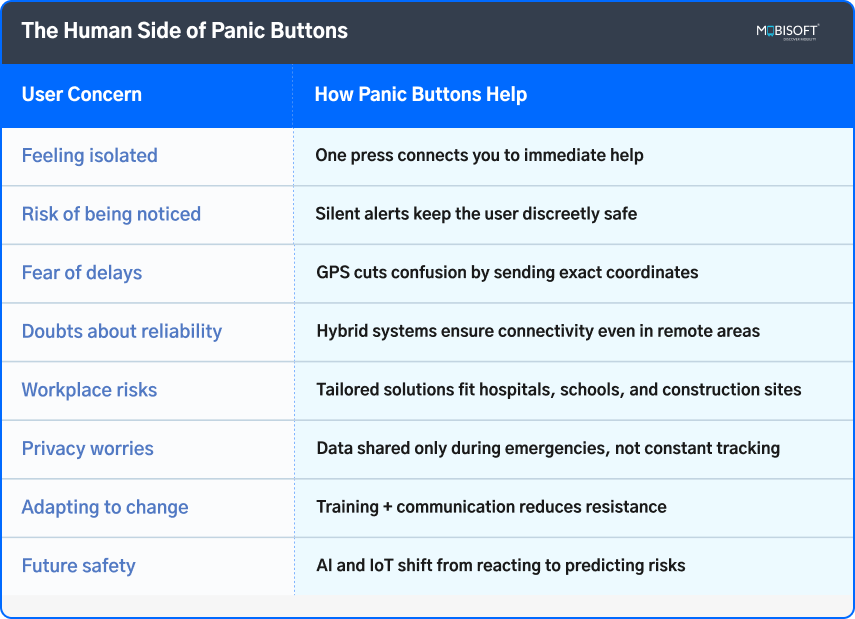
Future Trends in GPS Panic Button and Emergency Alert Technology
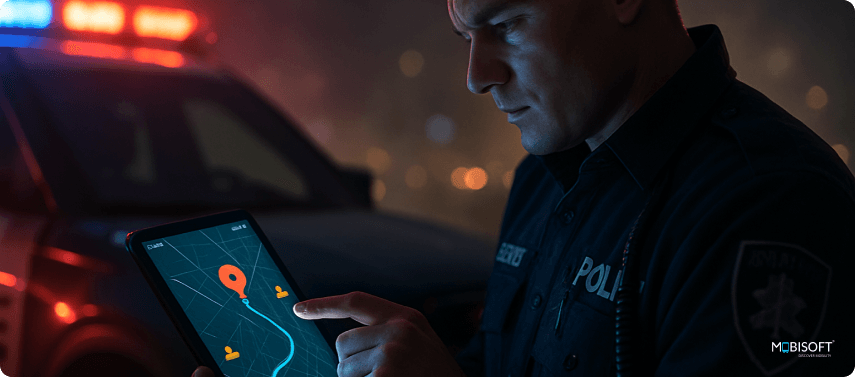
Panic buttons coupled with IoT, GPS tracking, and live tracking have been one of the significant evolutions in addressing emergencies. They together minimize response time and make communities and workplaces safer.
The IoT panic button market will be valued at USD 2.85 billion by the end of 2025 and will be worth USD 5.84 billion by 2033 (8.5% CAGR). With rising safety risks, such tools cannot be looked at as voluntary by organizations. In the future, technology will improve, and emergency response times will be defined by artificial intelligence.
Offices will depend on synergy between man and technology. Managers will be required to define policies, try out systems, and accommodate fresh solutions when they appear. Ongoing training keeps staff equipped to use enhanced panic button systems with GPS and live tracking effectively.
For shared mobility, panic buttons for safety in shared mobility ensure commuters’ security and faster emergency response. Explore Panic buttons for safety in shared mobility
Key Takeaways on GPS-Enabled Panic Buttons and Live Tracking
- Panic buttons eliminate delays by providing women with an immediate channel of help at the moment they perceive a threat.
- This allows for real-time location sharing while also helping accelerate rescues by giving responders accurate directions.
- Panic buttons with GPS tracking offer safety to all kinds of commuters through the application features and hidden wearable devices.
- Geofencing and silent alerting are examples of Advanced capabilities that add to the security while remaining stealthy.
- There are real-life instances of panic button usage that prove their importance in reestablishing trust and safety during trips.
- Training and clear protocols help reduce false alarms and build confidence in the system.
- Awareness drives and drill practices encourage women to feel comfortable using the feature.
- For businesses, panic buttons demonstrate genuine concern, enhancing both retention and diversity.
- AI and IoT are pushing panic buttons from reactive tools to predictive safety systems.
- When tech goes side-by-side with a culture committed to women's safety and trust.
FAQs About Panic Buttons, GPS Tracking, and Emergency Alert Systems
Q1: In an emergency, how do panic buttons assist?
A: Panic buttons cut through confusion and panic haze by transmitting an instant message including your current position with GPS positioning, so responders know at once, with no explanation, exactly where you are.
Q2: Are only workplaces allowed to use panic buttons, or do individuals also use them?
A: They are incredibly versatile devices; many workplaces provide them for their staff members. There are also wearables and panic button apps incorporating GPS, which are available for everyone, especially for female travelers or work-from-home individuals.
Q3: How does an app differ from a wearable panic button?
A: Wearables, such as pendants or wristbands, offer a subtle and hands-free solution; however, panic button apps are often favored for their simplicity, as most users already possess smartphones. Ultimately, the decision rests upon your environment and individual preference.
Q4: Do panic buttons actually reduce response time?
A: Yes. Because of GPS capability, responders never squander time saying "Where are you?". They receive your coordinates at once. Research demonstrates that even one minute's reduction is lifesaving in the case of a medical or security emergency.
Q5: What if I press the panic button by mistake?
A: These emergency panic button systems are designed with several protection measures, such as an automatic cancellation option and a two-button press, to make false alarms a minimum eventuality. If an alarm should sound, security groups consider it as a precautionary action..
Q6: In what ways is my privacy safeguarded when GPS continuously monitors my location?
A: Good systems do not continuously report; they only report your location when you press the GPS-enabled panic button. The data is normally encrypted, saved only for emergencies, and policies are publicly posted for employees.
Q7: Are panic buttons very costly to install and maintain?
A: For companies, there's an upfront cost but frequently offset by grants, protection compliance benefits, and increased worker confidence. For workers, phone-based panic buttons with GPS are usually cheap or free.
Q8: What new developments will we see in panic button technology?
A: AI is also being implemented to predict risks by studying past events, while the use of IoT and GPS-enabled panic buttons will link panic buttons with cameras, access systems, and sensors to enable swift and smarter reactions.




 September 10, 2025
September 10, 2025


